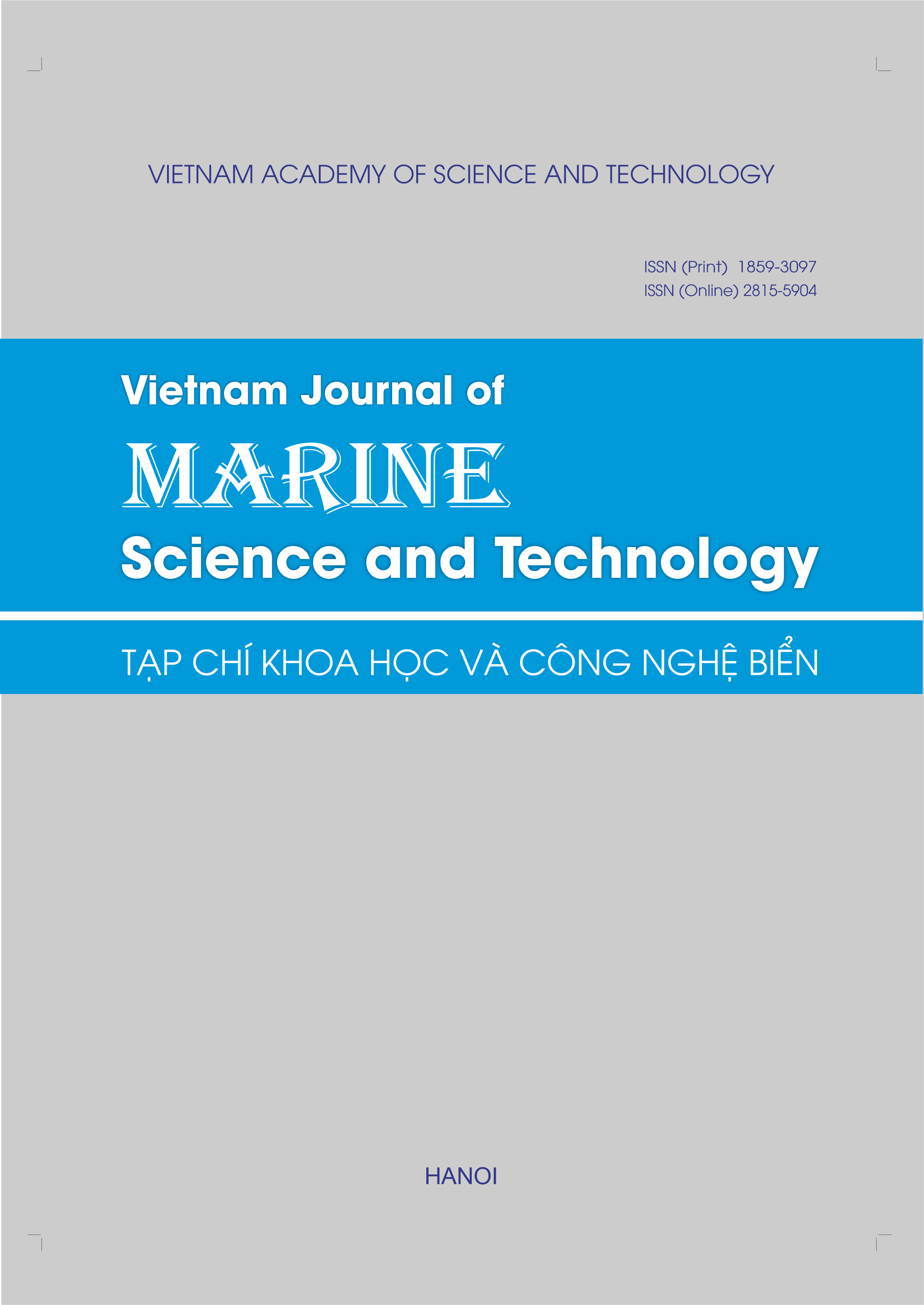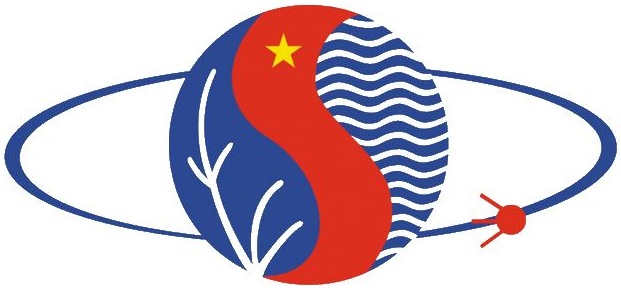Combination of molecular and traditional approaches to identify ice-ice disease causing bacteria on the seaweed Kappaphycus alvarezii (Doty)
Author affiliations
DOI:
https://doi.org/10.15625/1859-3097/22731Keywords:
Alteromonas, carrageenase, ice-ice disease, Kappaphycus alvarezii, Tenacibaculum, VibrioAbstract
The main cause of the disease is that bacteria thrive and attack seaweed by secreting carrageenan hydrolyzing enzyme, making it more vulnerable to other microbial pathogens. In this study, the bacterial composition of healthy and ice-ice samples of Kappaphycus alvarezii were analyzed by sequencing one hundred 16S rRNA gene of random clones from relevant gene libraries. In addition, the conventional method was used to isolate bacteria from the ice-ice disease seaweed and identify carrageenan hydrolyzing bacteria. Our results displayed a significant difference in the number of bacterial operational taxonomic units (OTUs) between the healthy (11 OTUs) and disease samples (31 OTUs). Bacterial composition in the healthy algal samples was dominated by two genera Cobetia and Roseobacter, which accouted for 39% and 21% of the total, respectively. In contrast, the ice-ice disease algal sample was dominated by the genera Pseudoalteromonas and Phaeobacter, which accouted for 14% and 12% respectively, closely followed by three genera Alteromonas, Salinimonas and Psychrobacter. After screening bacterial isolates from the ice-ice disease sample for carrageenan, two types of isolates were visually observed to produce this enzyme, indicated by a clear halo zone on 0.5% carrageenan agar plate. Two carrageenan-producing isolates were subsequently identified and named as Alteromonas sp. IKS 3 and Tenacibaculum sp. IKS4. In the pathogeny test, at 5 × 104 CFU/mL, the isolates IKS3 and IKS4 caused an ice-ice disease syndrome to 75.33% and 59.66% K. alvarezii seaweed respectively, higher than that of the control (22%, without any isolate infection), indicating that Alteromonas sp. IKS3 and Tenacibaculum sp. IKS4 was an ice-ice disease that caused bacteria on the K. alvarezii seaweed.
Downloads
References
[1] D. McHugh, A Guide to the Seaweed Industry. Rome: FAO Fisheries Technical Paper No. 441, 2003, 105 p.
[2] M. Ohno, H. Q. Nang, and S. Hirase, “Cultivation and carrageenan yield and quality of Kappaphycus alvarezii in the waters of Vietnam,” Journal of Applied Phycology, vol. 8, pp. 431–437, 1996. DOI: 10.1007/BF02178588.
[3] R. Campbell and S. Hotchkiss, “Carrageenan industry market overview,” in Tropical Seaweed Farming Trends, Problems, and Opportunities, A. Q. Hurtado, A. T. Critchley, and I. C. Neish, Eds., Developments in Applied Phycology, vol. 9. Cham, Switzerland: Springer International Publishing, 2017, pp. 193–205.
[4] M. S. Doty and V. B. Alvarez, “Status, problems, advances and economics of Eucheuma farms,” Marine Technology Society Journal, vol. 9, pp. 30–35, 1975.
[5] D. B. Largo, “Recent developments in seaweed diseases,” in Proceedings of the National Seaweed Planning Workshop, Tigbauan, Iloilo, Philippines: Southeast Asian Fisheries Development Centre Aquaculture Department, 2002, pp. 35–42.
[6] W. G. Mendoza, N. E. Montano, E. T. Ganzon-Fortes, and R. D. Villanueva, “Chemical and gelling of infected Kappaphycus alvarezii by ice-ice disease,” Journal of Applied Phycology, vol. 14, pp. 409–418, 2002.
[7] D. B. Largo, K. Fukami, and T. Nishijima, “Occasional pathogenic bacteria promoting ice-ice disease in the carrageenan-producing red algae Kappaphycus alvarezii and Eucheuma denticulatum (Solieriaceae, Gigartinales, Rhodophyta),” Journal of Applied Phycology, vol. 7, pp. 545–554, 1995. DOI: 10.1007/BF00003941.
[8] E. Syafitri, S. B. Prayitno, W. F. Ma’Ruf, and O. K. Radjasa, “Genetic diversity of the causative agent of ice-ice disease of the seaweed Kappaphycus alvarezii from Karimunjawa island, Indonesia,” in IOP Conference Series: Earth and Environmental Science, vol. 55, no. 1, 012044, 2017. DOI: 10.1088/1755-1315/55/1/012044.
[9] S. M. Riyaz, N. S. Prabhu, S. Nalini, G. Tejaswini, H. J. Christy, and D. Inbakandan, “Microbiome identification from ice ice disease infected Kappaphycus alvarezii using 16S rRNA gene sequence analysis and in silico docking studies against carrageenan degrading bacteria,” Biocatalysis and Agricultural Biotechnology, vol. 27, 101707, 2020. DOI: 10.1016/j.bcab.2020.101707.
[10] A. Azizi, N. Mohd Hanafi, M. N. Basiran, and C. H. Teo, “Evaluation of disease resistance and tolerance to elevated temperature stress of the selected tissue-cultured Kappaphycus alvarezii Doty 1985 under optimized laboratory conditions,” 3 Biotech, vol. 8, no. 8, 321, 2018. DOI: 10.1007/s13205-018-1354-4.
[11] T. Lachnit, D. Meske, M. Wahl, T. Harder, and R. Schmitz, “Epibacterial community patterns on marine macroalgae are host‐specific but temporally variable,” Environmental Microbiology, vol. 13, no. 3, pp. 655–665, 2011. DOI: 10.1111/ j.1462-2920.2010.02371.x.
[12] G. A. Kopprio, N. D. Luyen, T. M. Duc, T. H. Ha, L. M. Huong, and A. Gärdes, “Carrageenophyte-attached and planktonic bacterial communities in two distinct bays of Vietnam: Eutrophication indicators and insights on ice-ice disease,” Ecological Indicators, vol. 121, 107067, 2021. DOI: 10.1016/j.ecolind.2020.107067.
[13] R. I. Griffiths, A. S. Whiteley, A. G. O'Donnell, and M. J. Bailey, “Rapid method for coextraction of DNA and RNA from natural environments for analysis of ribosomal DNA- and rRNA-based microbial community composition,” Applied and Environmental Microbiology, vol. 66, no. 12, pp. 5488–5491, 2000. DOI: 10.1128/AEM.66.12.5488-5491.2000.
[14] E. D. Moore, A. Arnscheidt, A. Krüger, C. Strömpl, and M. Mau, “Simplified protocols for the preparation of genomic DNA from bacterial cultures,” Molecular Microbial Ecology Manual, vol. 1, no. 1, pp. 1–15, 1999.
[15] N. Wu, K. Matand, B. Kebede, G. Acquaah, and S. Williams, “Enhancing DNA electrotransformation efficiency in Escherichia coli DH10B electrocompetent cells,” Electronic Journal of Biotechnology, vol. 13, no. 5, pp. 21–22, 2010.
[16] S. Kumar, G. Stecher, and K. Tamura, “MEGA7: molecular evolutionary genetics analysis version 7.0 for bigger datasets,” Molecular Biology and Evolution, vol. 33, no. 7, pp. 1870–1874, 2016. DOI: 10.1093/molbev/msw054.
[17] R. V. Azanza, V. M. D. Vargas, K. Fukami, K. Shashank, D. Onda, and M. Azanza, “Culturable algalytic bacteria isolated from seaweeds in the Philippines and Japan,” Journal of Environmental Science, Special Issue 1–2013, pp. 1–10, 2013.
[18] S. M. Riyaz, D. Inbakandan, D. Manikandan, P. Bhavadharani, J. Elson, N. S. Prabhu, T. S. Dhas, S. Nalini, M. B. Latha, and J. Simal-Gandara, “Microbiome in the ice-ice disease of the farmed red algae Kappaphycus alvarezii and degradation of extracted food carrageenan,” Food Bioscience, vol. 42, 101138, 2021. DOI: 10.1016/j.fbio.2021. 101138.
[19] V. V. Mangun, R. Sugumaran, W. T. L. Yong, and N. A. Yusof, “Dataset of 16S ribosomal DNA sequence-based identification of endophytic bacteria isolated from healthy and diseased Sabah red algae, Kappaphycus alvarezii,” Data in Brief, vol. 51, Art. no. 109785, 2023. DOI: 10.1016/j.dib.2023.109785.
[20] M. Achmad, A. Indarjo, and G. Salim, “Identification of bacteria in seaweed (Kappaphycus alvarezii) affected by the ice-ice disease in Amal and Tanjung Tarakan waters, Indonesia,” AACL Bioflux, vol. 15, no. 6, pp. 3061–3068, 2022.
[21] S. M. Riyaz, S. Nalini, G. Kavitha, S. A. D. Sutha, and D. Inbakandan, “Characterization and identification of isolated bacteria from ice-ice disease infected seaweed Kappaphycus alvarezii,” Indian Journal of Geo Marine Sciences, vol. 48, no. 08, pp. 1286–1290, 2019.
[22] A. A. Yusriyyah, A. C. M. A. Tassakka, and G. Latama, “Identification of the potential of degrading carrageenan in red algae Kappaphycus alvarezii symbiotic bacteria,” International Journal of Environment, Agriculture and Biotechnology, vol. 6, no. 1, pp. 81–85, 2021. DOI: 10.22161/ijeab.61.11.
[23] V. M. Butardo, E. T. Ganzon-Fortes, V. Silvestre, M. B. B. Bacano-Maningas, M. N. E. Montano, and A. O. Lluisma, “Isolation and classification of culturable bacteria associated with ice-ice disease in Kappaphycus and Eucheuma (Rhodophyta, Solieriaceae),” Philippine Scientist, vol. 40, pp. 223–237, 2003.
[24] D. Zhao, B. Jiang, Y. Zhang, W. Sun, Z. Pu, and Y. Bao, “Purification and characterization of a cold-adapted κ-carrageenase from Pseudoalteromonas sp. ZDY3,” Protein Expression and Purification, vol. 178, p. 105768, 2021. DOI: 10.1016/j.pep.2020.105768.
Downloads
Published
How to Cite
Issue
Section
License
Copyright (c) 2025 Vietnam Academy of Science and Technology

This work is licensed under a Creative Commons Attribution-NonCommercial-NoDerivatives 4.0 International License.








